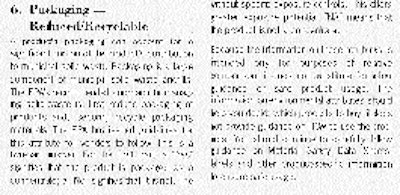The Environmental Protection Agency apparently intends to leave its draft guidance on environmentally preferred products waving from the flagpole, even though numerous industry groups have shot it through with holes. The guidance is supposed to be used by all federal agencies, not just the EPA. Packaging was covered both obliquely and directly in areas such as environmental product characteristics and life cycle analysis. Those sections and others brought angry written denunciations last December from the Society of the Plastics Industry (SPI), Grocery Manufacturers of America (GMA), the Foodservice & Packaging Institute (FPI) and other groups too numerous to mention. Recent interviews show industry leaders still mad as hell. Elizabeth Seiler, director of the environmental affairs department for the GMA, says, "The EPA cannot leave that draft guidance out there dangling, letting federal procurement people interpret it any way they want. It leaves a lot of important issues open. If the guidance is going to be used, those issues need to be resolved, which would necessitate another draft." Eun-sook Goidel, the senior staffer in EPA's office of pollution prevention and toxics, who is in charge of the guidance, says the agency has no plans at the moment to revise the draft. Some of the issues raised in the draft will be clarified in other venues such as pilot projects, she says, or in possible EPA policy statements on narrow issues, such as third-party certification. The guidance stems from an Executive Order issued by President Clinton on October 20, 1993. The draft issued last September by the EPA lists seven principles that federal buyers should use. There is also an appendix listing environmental performance characteristics of note and another dealing with life cycle analysis. The EPA asked for comments, and received a raft of them in December. Starting clean-up The guidance is already being used in a project on cleaning products run by the General Services Administration (GSA), the first in an expected series of pilot projects. As part of that program, the GSA has been publishing a Commercial Cleaning Supplies Brochure (shown above), produced in conjunction with the EPA, for biodegradable cleaners and degreasers. In its latest revision in March 1996, the brochure included for the first time a matrix of seven environmental product attributes, one of which was packaging. The vendors who voluntarily submitted information had their packaging rated based on two factors: whether the product was concentrated, thus requiring less packaging than if the product had been diluted, and whether any paper packaging followed EPA guidelines on use of recovered materials. These brochures are sent to government buyers in every federal agency and cabinet department. A second pilot project, as yet unannounced, will involve the purchase of paving materials by the Department of Defense. Of course, the draft guidance can be used by purchasing officials in any agency, for any product. The continued use of the reviled guidance is affront enough to many industry groups. But their seething would undoubtedly turn to legal action if federal buyers started making purchase decisions based on whether Green Seal endorsed a particular product. Role for Green Seal? That scenario is in the offing. Arthur Weissman, vice president of standards and certification for Green Seal, says, "We are negotiating with several federal agencies now." He declines to identify them. Weissman notes that the draft guidance is complex, and federal agencies, notably the General Services Administration, would benefit from clearer guidance on what products to buy. He notes that in product categories such as cleaning products, packaging is a big factor in a Green Seal endorsement. The GMA has been especially concerned about the issue of third-party certification. That was discussed in the seventh of the seven principles the EPA laid out in the draft guidance. The key wording is the statement that federal agencies should not make procurement decisions based on third-party certification programs "that do not generally meet certain characteristics." The EPA asked for comment on that issue, and much of it was negative. The GMA argued the guidance "should not become a back door to a government-supported system of eco-seals in the United States" (see PW, May '96, page 26). But the GMA said that the EPA kicked that back door wide open by implying in Principle Seven that eco-seals could be relied on if they "generally meet certain characteristics." That language also seems to run counter to wording in the preamble of the guidance which says: "Executive agencies need to ensure that an acquisition decision does not turn on an unverified policy, or a value judgement by a non-government entity." With regard to third-party certification, the EPA's Goidel says she hopes to clear up confusion soon. "There is some concern on both sides that things will get done on an ad hoc basis," she explains. "This might lead to inaction on the part of federal purchasers. It is my job to push the envelope." Other objections Even packaging trade associations that agree with the concept of environmentally preferred products had nits to pick. Rick Norment, executive director of the Steel Shipping Container Institute, is concerned that the EPA will be swayed by perception or image rather than facts when it decides which products are really environmentally preferred. He notes that the recycled content in steel shipping containers-which the federal government buys at the rate of one million a year-is considerably higher than materials like polyethylene terephthalate (PET) and paper. But he argues that PET and paper have better environmental images, mostly because of million-dollar advertising campaigns, such as television ads from Weyerhauser, that position those products as "nice warm fuzzy materials." Adds Norment, "If they choose the most environmentally friendly packaging, it will be steel." Others argue the EPA has no business issuing any guidance, period. "While making some important strides forward, EPA's proposed guidance is erroneously premised on the notion that EPA can and should offer simple, easy- to-apply generic guidance that will magically clarify an inherently difficult decision-making process for procurement officials," says Maureen Healey, director of federal, environmental and transportation issues for the SPI. "It cannot." Industry's heated reaction to the proposed guidance is also driven by its perceived influence. Marla Donahue, vice president of public affairs for the Foodservice & Packaging Institute, Inc., worries that if the EPA proposed guidance takes hold in the federal government, state governments will follow along, and so will private industry. The FPI agrees that the guidelines should be withdrawn. The FPI's Donahue has a big problem with the menu of 25 environmental characteristics that the EPA suggests should be used in making a purchasing decision. First, she thinks the criteria vary from very simple measures such as recycled content to very complex issues such as ecosystem impacts, bioaccumulative pollutants and immunotoxicity. "Accurate measuring systems do not exist for all these attributes and the scientific community has not agreed on the mechanisms to evaluate their impacts," she explains. She also wants to see "microbiological contaminants" included as human health stressors. This would give a boost to single-service cups, utensils and packaging. c


























